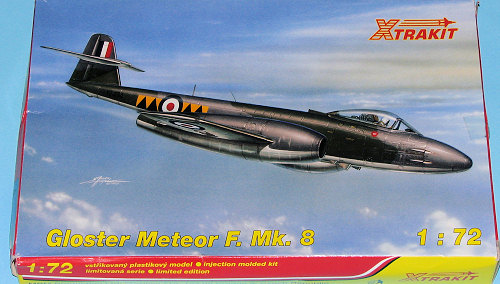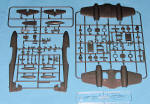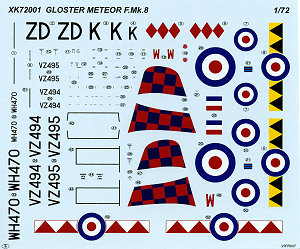
| KIT: | Xtrakit 1/72 Gloster Meteor F.8 |
| KIT #: | XK 72001 |
| PRICE: | $ |
| DECALS: | Three options |
| REVIEWER: | Scott Van Aken |
| NOTES: | Short run kit |

| HISTORY |
The first prototype F8 was a modified F4, followed by a true prototype, VT150, that flew on 12 October 1948at Moreton Valence. Flight testing of the F8 prototype led to the discovery of an aerodynamic problem. When ammunition was expended, the aircraft became tail-heavy and unstable around the pitch axis due to the weight of fuel retained in fuselage tanks no longer being balanced by the ammunition. Gloster designers cleverly solved the problem by substituting the tail of the abortive "G 42" single-engine jet fighter. The F8 and other production variants were to successfully use the new tail design; the new tail gave the later Meteors a distinctive appearance, with taller straighter edges compared to the rounded tail of the F4s and earlier marks.
The F8 also featured a fuselage stretch of 76 centimetres (30 inches), intended to shift the aircraft's centre of gravity and also eliminate the use of ballast that had been necessary in earlier marks. The F8 incorporated uprated engines, Derwent 8s, with 16 kN (1,633 kgp / 3,600 lbf) thrust each combined with structural strengthening, a Martin Baker ejection seat and a "blown" teardrop cockpit canopy that provided improved pilot visibility. Between 1950 and 1955, the Meteor F8 was the mainstay of RAF Fighter Command, and served with distinction in combat in Korea with the RAAF as well as operating with many air forces worldwide, although it was clear that the original design was obsolescent compared to contemporary swept-wing fighters such as the North American F-86 Sabre and the Soviet's MiG-15.
Initial deliveries of the F8 to the RAF were in August 1949, with the first squadron receiving its fighters in late 1950. Like the F4, there were strong export sales of the F8. Belgium ordered 240 aircraft, the majority assembled in Belgium, the Netherlands had 160 F8s, equipping seven squadrons until 1955. Denmark had 20, ordered in 1951; they were to be the last F8s in front line service in Europe. The RAAF ordered 94 F8s, which served in Korea - see below. Despite arms embargoes, both Syria and Egypt received F8s from 1952, as did Israel (where they served until 1961). On 1 September 1954, two Israeli F8s shot down two Egyptian Vampires and in the 1956 Suez Crisis, F8s were employed by both Egypt and Israel in ground-attack roles. After the crisis, both Egypt and Syria disposed of their Meteors in favour of various MiG variants. Brazil received around 60 new built F8s in 1953.
There is one Meteor F.8 still flying.
| THE KIT |
 This is, of course, an MPM kit in a Hannants box. The return addy on the outside is the Czech Republic and not the UK. Molded in medium grey plastic, the kit is very nicely detailed for a short run kit. There is a full cockpit with floor, side consoles, instrument panel, seat, instrument panel and all. It includes a three piece seat, though perhaps one might want to consider an aftermarket replacement if one is around as it is a bit simple and it is also about the only thing you'll really see in the cockpit once the one-piece canopy is glued on. A metal aftermarket seat will also give some needed weight to the nose. Instructions say 3 grams. Put in at least 6!
This is, of course, an MPM kit in a Hannants box. The return addy on the outside is the Czech Republic and not the UK. Molded in medium grey plastic, the kit is very nicely detailed for a short run kit. There is a full cockpit with floor, side consoles, instrument panel, seat, instrument panel and all. It includes a three piece seat, though perhaps one might want to consider an aftermarket replacement if one is around as it is a bit simple and it is also about the only thing you'll really see in the cockpit once the one-piece canopy is glued on. A metal aftermarket seat will also give some needed weight to the nose. Instructions say 3 grams. Put in at least 6!
Nose gear and main gear have a separate fork for the wheel, providing a weak point so be sure to get that as solid as you can. Tail planes slot into the leading edge of the fin. The engine intake sections are well done and show a lot of detail that is supposed to be the casing of the engine I guess. I'd thought that the intake was smooth into the first stage of compression. The kit also has separate wheel wells. I should mention that this is all plastic with no resin, photo etch or vacuformed parts.
I should mention that all the markings options are for the small intake engines. There are separate large intake inlets provided, but they are crossed out. Means that if you are going aftermarket for the markings, the large inlets are available, which is nice. The kit provides optional belly tank and wing tanks. One must decide before cementing the wing  halves as to which are to be used as holes need to be opened for the wing tanks. It was not uncommon for these thirsty jets to carry both. You also get two canopies. There is a version where the aft section is metal and that is used on two of the markings options.
halves as to which are to be used as holes need to be opened for the wing tanks. It was not uncommon for these thirsty jets to carry both. You also get two canopies. There is a version where the aft section is metal and that is used on two of the markings options.
Instructions are well done and provide Xtracolor paint references as well as FS 595. The markings are for three aircraft. One is the box art aircraft from 501 Sq (perhaps this should be 601 Sq) in 1957. This is in Dark Sea Grey/Dark Green over Aluminum and would probably be glossy. I would have thought that a later F.8 would have had the large engine inlets. Next is an overall High Speed Silver aircraft from 222 Sq in the early 1950s. this is the Squadron Commander's plane with the black and red checks on the fin. Finally, another High Speed Silver plane from 600 Sq in the early 1950s. This has the red and white triangles. These are also supplied for the wing tips, but the modeler must paint the tips white first. Decals are very nicely printed and include a stencil suite as well.
| CONCLUSIONS |
I know that I've built three Meteor F.8s in this scale over the years. One was a Rareplanes vacuform kit, one was a Merlin kit (still have nightmares about that one), and the other was an Aeroclub conversion for the Matchbox kit. This one is the definitive kit and if you like the aircraft, you need to buy lots!
| REFERENCES |
August 2007
You can find this one and lots of other stuff atwww.hannants.co.uk. If you would like your product reviewed fairly and quickly by asite that has nearly 400,000 visitors a month, please contactme or see other details in the